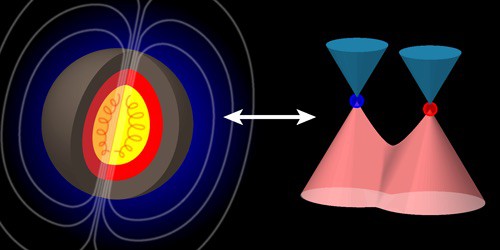Benchtop cosmology exploits solid-state systems
10 Nov 2018 Anna Demming
The kind of dynamos thought to be behind the huge magnetic fields found in stars and galaxies, may also exist in Weyl semimetals, materials more common to a solid-state laboratory. Why does this matter? As Belle Dumé points out, the presence of dynamos capable of generating and sustaining a magnetic field in readily available metal systems could provide a handy lab-sized model for what researchers Victor Galitski, Mehdi Kargarian, and Sergey Syzranov describe as the “beautiful astrophysical phenomenon, first proposed by Larmor in 1919.”
Wily Weyls
While a Weyl metal may be found in more manageable proportions than a star or a galaxy, these materials are not without their own brand of exoticism. Electronic excitations in these crystals take the form of charge carrying Weyl fermions – massless chiral quasiparticles.
The discovery of Weyl points is not only the smoking gun to a scientific mystery
Hermann Weyl predicted their existence in his solution of the Dirac equation, and they have contributed to some of the keystones in fundamental physics – quantum field theory and the standard model. Crucial but elusive, Weyl fermions were not observed for more than 85 years, when two separate reports of them appeared. In 2015 M. Zahid Hasan at Princeton University in the US and colleagues in the US, China, Taiwan and Singapore reported experimental observations of a Weyl metal in TaAs single crystals. Elswhere Marin Soljačić and colleagues at Massachusetts Institute of Technology in the US and Zhejiang University in China spotted evidence for Weyl fermions in a a “double-gyroid” photonic crystal. “The discovery of Weyl points is not only the smoking gun to a scientific mystery,” said Soljačić, adding, “it paves the way to absolutely new photonic phenomena and applications.”

Just a few months later researchers at ETH Zurich in Switzerland, Princeton University in the US and the Chinese Academy of Sciences extended the family of Weyl semimetals with their predictions of a new type of Weyl semimetals. When solving the Dirac equations Weyl had conscientiously maintained Lorentz symmetry, an important invariance principle for particle physicists. For condensed matter researchers Lorentz symmetry is not such an issue and by generalizing the Dirac equation Alexey A. Soluyanov and colleagues revealed the type II Weyl semimetal.
More recently studies of the type-II Weyl semimetal phase of MoTe2 solicited yet more interest. Jian-Hao Chen and colleagues at Peking University, Collaborative Innovation Center of Quantum Matter and Tsinghua University in China observed resistivity jumps that indicated the Barkhausen effect. More than just a useful way of characterizing ferroelectric and ferromagnetic materials, the Barkhausen effect is a stochastic process that shows universality – “the observation that a wide range of macroscopic systems behave in much the same way, even if the systems have different microscopic components” as Hamish Johnston explains in his coverage of no less than three Nature reports of universal behaviour in systems far from equilibrium.READ MORE

Weyl you’re not alone
Given their recent track record, perhaps the possibility of gaining insights from Weyl semimetals as to the origins of magnetism in vast astrophysical objects is less of a surprise. However they are not the only systems to have provided convenient solid-state analogues for probing cosmological phenomena. In July Dumé also reported theoretical calculations by a team in Canada, the US, UK and Israel revealing a quantum hologram in a graphene flake that faithfully reproduces some of the signature characteristics of a black hole.
“In recent years, physicists have gleaned important new insights into these questions through the study of the SYK [Sachdev-Ye-Kitaev] model,” explained lead researcher Marcel Franz of the University of British Columbia in Canada. “This model is an illustration of a type of ‘holographic duality’ in which a lower-dimensional system can be represented by a higher dimensional one. In our calculations, the former is N graphene electrons in (0+1) dimensions and the latter the dilation gravity of a black hole in (1+1) dimensional anti-de Sitter (AdS2) space.”
The graphene flake must meet certain requirements: it must have an irregular boundary because of the random structure of electron-electron interactions in the SYK model they use, and it is subjected to an intense magnetic field. Nonetheless it is straightforward to fabricate and far easier to handle than a black hole.

10/11/2018 from physicsworld.com

Δεν υπάρχουν σχόλια:
Δημοσίευση σχολίου